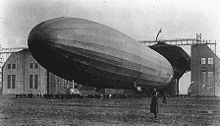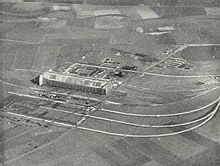LZ 104
LZ 104 was a Zeppelin airship military type W in the First World War . His tactical number was L 59 . The first trip took place on October 30, 1917. Together with the L 57, the L 59 and the last military airships built, the LZ 112 and LZ 113, were among the four largest airships of the First World War. The airship is considered to be the most efficient transport airship ever built over long distances.
career
LZ 104 was specially built to supply the protection force in German East Africa during the First World War . Since the airship was not to return after the supply flight to Africa, many parts of the airship could be reused for the field work of the troops. Its outer shell could be made into tents and sometimes gauze bandages , for example. The aluminum frame should be used for stretchers , barracks or transmission masts .
Africa trip
The supply of the German protection force in East Africa by means of auxiliary ships became more and more difficult due to the British North Sea blockade. In addition, the proponents of military airship travel were urgently looking for prestige success. Originally, LZ 102 (tactical no. L 57 ) was supposed to undertake a transport trip to German East Africa. However, on October 7, 1917, the LZ 102 was badly damaged by squalls at the airship port in Jüterbog before it could start its journey. The LZ 104 , which was still under construction, was then prepared for the company. LZ 104 had to be built 30 meters longer than originally planned. LZ 104 was put into service on October 25, 1917 . On November 3rd, the ship started from Berlin-Staaken for the Africa mission. The command led Kapitänleutnant Ludwig Bockholt , who was supposed to carry out the journey from LZ 102 .
In order to reduce the distance of non-stop travel , the airship port at Jambol (Jamboli) in southeastern Bulgaria , which was on the side of the Central Powers , was chosen as the launch site . LZ 104 arrived in Jamboli on November 4th. On November 13th, unfavorable weather conditions prevented the start towards Africa. On November 16, the second attempt also failed, when LZ 104 came under fire at Akhisar over Asia Minor by Ottoman units , which were also on the side of the Central Powers. Captain Bockholt had to turn back because of gas loss and bad weather again.
Freight for German East Africa
On November 21, 1917 at 5 a.m., the airship took off again from Jamboli with a total load of around 50 tons on board.
The cargo consisted of the following items:
| Post | number | Weight |
|---|---|---|
| Cartridges (single) | 311,900 pieces | 7,866 kg |
| Machine gun belts with 57,500 belted cartridges | 230 pieces | 1,748 kg |
| Machine gun cartridge boxes with 13,500 cartridges | 54 pieces | 441 kg |
| Machine guns | 30 pieces | 510 kg |
| Infantry rifles with 5,000 cartridges | 4 pieces | 240 kg |
| Reserve barrels for machine guns | 9 pieces | 171 kg |
| Bandages and medication | 61 sack | 2,622 kg |
| Sewing kit | 3 bags | 120 kg |
| post Office | - | 25 kg |
| Telescopes | - | 28 kg |
| Replacement locks | - | 50 kg |
| Machete and belt filler | - | 76 kg |
| Replacement device for radiotelegraphy | - | 33 kg |
| petrol | - | 21,790 kg |
| oil | - | 1,525 kg |
| water | - | 9,160 kg |
| Drinking water | - | 426 kg |
| Garment bags | - | 380 kg |
| Other spare parts | - | 350 kg |
| Food (canned food etc.) | - | 700 kg |
| Crew (22 people) | - | 1,760 kg |
| total | - | 50,021 kg |
Route
There are various records of the exact route, as there are several maps with slightly different routes. In general, the information agrees that on November 21, 1917 LZ 104 initially drove along the European Turkey, Asia Minor and Smyrna (now Izmir ) line. German aircraft operating from Ottoman bases provided escorts. A route followed from Kos over the Aegean Sea to the eastern end of Crete . This was followed by the journey across the eastern Mediterranean to the African coast, which was crossed at around Sallum and Sidi Barrani . Furthermore happened LZ 104 the oases of Siwa , Farafra and Dakhla in Egypt . It was not until Sudan that the Nile was touched , for example from Wadi Halfa .
The Makonde Plateau in the southeast of what is now Tanzania was considered as the landing site in East Africa .
Termination of the Africa trip
When Khartoum appeared far on the horizon , LZ 104 received the following radio message from Nauen near Berlin:
“Last base Lettow-Vorbeck , Revala, lost. Entire Makonde highlands owned by the English. Parts of Lettov captured. Rest of the north hard pressed. Turn around immediately! "
Thereupon LZ 104 turned around after it had already covered a large part of the distance. The most southerly position was approximately 16 ° 30 ' N , 30 ° 0' O . Shortly after the reversal of the airship through was downdrafts almost down to the desert floor. The route of the return trip was similar to the outward journey over Sudan, Egypt and the Mediterranean. Asia Minor was crossed a little further east and Istanbul passed. In the morning hours of November 25, 1917, the starting point at Yambol was finally reached again.
During the journey, the airship set a long-distance record. LZ 104 covered a distance of 6757 kilometers in 95 hours and five minutes .
Lettow-Vorbeck doubted in retrospect that LZ 104 would have found him and his troops at all. In his opinion, the trip was a month late. There were also indications that the British were aware of the Zeppelin mission, which later sparked rumors of espionage acts and alleged false reports. The historian Horst Gründer came to the conclusion that the Admiral's staff had the trip aborted at the instigation of the Reich Colonial Office, as the likelihood of failure seemed too great due to the fact that the battle situation had deteriorated from a German perspective.
Further use and whereabouts
After the failed African company, LZ 104 was converted for use at the front. A repetition of the company considered by Bockholt was rejected. To carry out the conversion, the airship was back in Germany at the turn of the year 1917/18. In early 1918, LZ 104 was used for attack trips to the Middle East and Italy . In the further course of the war, LZ 104 dropped 6,400 kilograms of bombs. On March 10, 1918, the ship bombed the naval base and industrial facilities of Naples . On March 20, 1918, an attack on Port Said had to be stopped prematurely due to strong headwinds. On April 7, 1918, the zeppelin crashed into the Mediterranean Sea over the Strait of Otranto during an attack against Malta . The crew of the German submarine UB 53 witnessed the crash, in which there were no survivors.
Technical specifications
| length | 226.5 m |
| Largest diameter | 23.9 m |
| Impingement gas content | 68,500 m³ of hydrogen |
| Number of gas cells | 16 |
| Empty weight | 27,600 kp |
| Payload (0 ° C, 760 mmQS ) | 51,900 kp |
| Engines | 5 Maybach HSLu engines, each 240 hp |
| propeller | 4 Jaray wooden propellers |
| Static peak height | 8,200 m (?) |
| Range | 16,000 km |
| Top speed | 103 km / h |
literature
- Wolfgang Meighörner-Schardt: pioneer of world air traffic against his will . Zeppelin Museum, Friedrichshafen 1992, ISBN 3-926162-58-9 .
- Johannes Goebel: Africa at our feet. Koehler, Leipzig 1925. (Later title: 40,000 km zeppelin war journeys ).
- Peter Meyer: Airships - The History of the German Zeppelins . Bonn: Bernard & Graefe Verlag, 1996, p. 97f. ISBN 3-7637-5951-4 .
- Bock, JK / Knauer, B .: Lighter than air: transport and carrier systems . Verlag Frankenschwelle, Hildburghausen 2003, ISBN 3-86180-139-6 .
- Gisela Graichen; Horst founder: The longest flight in the world - With the zeppelin to East Africa, in (ders.); German Colonies - Dream and Trauma, Berlin: Ullstein, 2005, pp. 314-312, ISBN 3-550-07637-1 .
- Reinhard Klein-Arendt: The Africa flight of the airship L59, in (ders.); "Kamina calls Nauen!" The radio stations in the German colonies 1904-1918 . Cologne: Wilhelm Herbst Verlag, 1995, pp. 319-325. ISBN 3-923-925-58-1
- Joachim Schröder: On a secret mission - The Africa flight of the airship "L 59", in: Clausewitz, The magazine for military history, 3 (2014), pp. 48–52.
- Karl-Dieter Seifert: German aviators over the colonies . Zweibrücken: VDM Heinz Nickel, 2007, p. 107ff. ISBN 978-3-86619-019-1 .
Web links
- Karl-Wilhelm Schäfer: Some aspects of the Africa voyage of the naval airship L 59. (PDF file, 13 pages, 99 kB)
- Airship Harry: Information on the cause of the accident and the location of the loss ( Memento from December 3, 2012 in the Internet Archive )
- Detailed curriculum vitae of Friedrich Engelke (crew member of LZ 104)
Individual evidence
- ↑ Reinhard Klein-Arendt: "Kamina calls Nauen!" The radio stations in the German colonies 1904-1918 . Cologne: Wilhelm Herbst Verlag, 1995, 321. ISBN 3-923-925-58-1
- ↑ Reinhard Klein-Arendt: "Kamina calls Nauen!" The radio stations in the German colonies 1904-1918 . Cologne: Wilhelm Herbst Verlag, 1995, 324. ISBN 3-923-925-58-1
- ↑ Johannes Goebel: Africa at our feet. Koehler, Leipzig 1925, pp. 113-119
- ↑ Wolfgang Meighörner-Schardt: pioneer of world air traffic against his will. Zeppelin Museum, Friedrichshafen 1992, p. 153.
- ^ Douglas H. Robinson: The Zeppelin in Combat. A History of the German Naval Airship Division, 1912-1918. Foulis, London 1971, p. 380.
- ^ Ludwig Dürr : Twenty-five years of Zeppelin airship construction. VDI-Verlag GmbH, Berlin 1924, p. 31.



